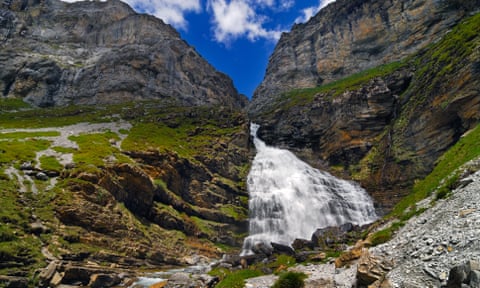Winning tip: Cola de Caballo, Pyrenees, Spain
The aptly named Cola de Caballo (horsetail) cascade is the most spectacular of the many along the Arazas River in the Spanish Pyrenean Ordesa national park. Taking the GR11 upstream from the park’s entrance, a three-hour hike takes you past increasingly dramatic falls. Another kilometre beyond the Cola is the beautifully isolated Góriz mountain refuge hut, where you can enjoy some of Europe’s most unpolluted night skies. The backdrop is the brooding grandeur of Monte Perdido (Lost Mountain) looking down from its 3,300-metre peak, and often you can see giant lammergeiers (also called bearded vultures) circling. To the north, across the French border is Gavarnie, another magnificent waterfall.
Alan
Aquafraggia Falls, Lombardy, Italy

A couple of weeks ago we went to the Notte delle Cascate festival which sprawls around the foot of the Acquafraggia Falls in the Val Bregaglia near Chiavenna. We sampled local food and wine as we wandered ever closer to the base of the dramatic falls – two tiers and twin streams dropping 130 metres off the valley wall – and found a good viewpoint to spread our blanket on the grass, and wait. There were river pools for kids to play in and lots of pop-up bars for refreshments. All this is the build up to the exciting climax: at 10pm a squad of abseilers, their bodies outlined with lights, slowly descend the falls in the dark. Magical.
Martha
Grawa, Austria

The Grawa waterfall is on the Wild Water Trail in the Stubai Valley. We travelled there by bus using the Stubai Super Card. Our walking group were the only ones there on a damp, misty morning. The 85-metre-wide waterfall wasn’t even in full flow but it was an awesome, thundering spectacle. When we revisited the next day, it was transformed: a bright, sunny afternoon had framed the waterfall with blue sky and green trees and brought many people out to enjoy the show from the wooden platform and seating.
Liz Young
Svartifoss, Iceland
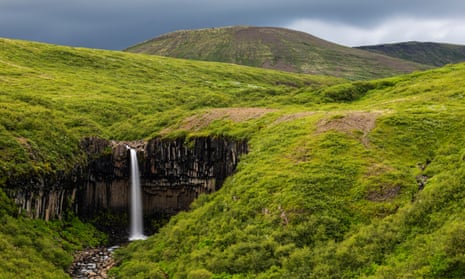
One of my most amazing experiences ever was to see the mystical Svartifoss waterfall in Iceland, in the south of Vatnajökull national park. Although this is not the biggest of the Icelandic “fosses”, the magic of the place was palpable. Magnificent octagonal basalt columns that surround Svatrifoss add something special. In the dying light of winter sun, the icy glow of falling glacier water was radiating extraordinary power. The hike to Svartifoss from the visitor centre in Skaftafell takes about 45 minutes each way. Every time I think about Svartifoss, my heart is filled with wonder.
Rod L
ProfileReaders' tips: send a tip for a chance to win a £200 voucher for a Coolstays break
Show
Guardian Travel readers' tips
Every week we ask our readers for recommendations from their travels. A selection of tips will be featured online and may appear in print. To enter the latest competition visit the readers' tips homepage
-
Søtefossen, Norway

If, like me, you’re obsessed with waterfalls, Norway is the promised land. No other country gives more bang for your buck. Unfortunately many of Norway’s cataracts are harnessed for the country’s huge hydroelectric industry. But a hike up the Kinso River bags you four of its finest unharnessed falls culminating in Søtefossen, a giant double leap down the headwall of the Husedalen. You start in Kinsarvik: there’s a bus stop in the village and a car park at the trailhead a few kilometres up the valley. The trail climbs 666 metres, it’s strenuous but the payoff is extraordinary.
Michael
Glen Maye, Isle of Man

A small but powerful force, Glen Maye waterfall in the Isle of Man plungesthrough a dramatic, intensely green gorge sheltered by mature woods and clothed in moss, ferns and trailing plants saturated by the river’s breath. When the river is not in full spate, the pool is an unforgettable place to swim – deep, wild, clear and exhilaratingly cold. A spirit of Manx folklore - the Cabbyl-Ushtey (Water Horse) – is said to dwell here. Glen Maye is a 10-minute drive from the western town of Peel. There’s a car park above the glen, from which you can follow the river down through the trees to the beach for a picnic.
Elizabeth
Cora Linn, South Lanarkshire
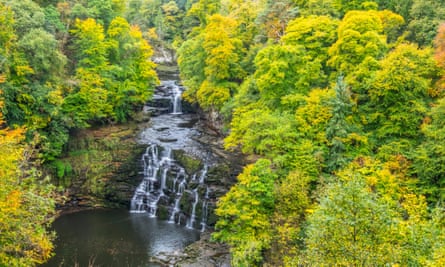
The most magical place in Central Scotland is the Cora Linn at the Falls of Clyde after a heavy rainfall. It can be reached by walking from the historic town of New Lanark via a well-maintained woodland pathway alongside the river where badgers and otters make their home. The falls have impressed and inspired poets and writers for centuries, including Wordsworth, Coleridge, and JMW Turner. The feeling of being miles from anywhere while being midway between Scotland’s major cities is sensational. And when you catch your first sight of the falls the feeling is glorious.
Moira
Mill and Whitfield Gill Force, Wensleydale, Yorkshire

Picturesque Askrigg in Wensleydale offers an enchanting five-mile round-trip to two fabulous but unheralded waterfalls, Mill Gill Force and Whitfield Gill Force. Park outside the church (free) and walk through backstreets and then meadows before meeting Mill Gill Beck in its wooded glade. You’ll soon be following the whooshing of the falls, descending to the first in a cavernous gully shrouded by cliffs and trees. Keep going to the even more spectacular Whitfield, before ascending out of the glen and taking a moorland track back to Askrigg, with commanding views over the dale. Refresh at the ancient and atmospheric King’s Arms, with its excellent food, ales, and friendly staff.
Daniel Ashman
Baatara Gorge waterfall, Lebanon
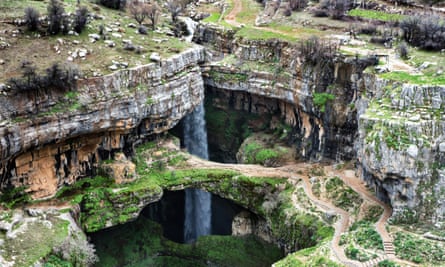
The Cave of Three Bridges near Tannourine village (a 90-minute drive from Beirut) is a primordial wonder. A vertical shaft of icy melt water drops 250 metres through a limestone cave. Over the centuries the water has carved three limestone arcs across the main chamber at the end of a dizzyingly steep gorge. The curved nature of the erosion and abundance of greenery give the impression of an imagined landscape, a sublime rendering of the natural world. The Baatara Gorge can be accessed by trail from the village of Mgharet al-Ghaouaghir and offers an insight into the incredible geology of this tiny, troubled country.
Gareth Roberts
Gocta Waterfall, Peru

It is well worth the trek to get to this astonishing waterfall. In cloud forest at the edge of the Amazon, in the Chachapoyas region, it is the most beautiful waterfall I’ve ever seen. Locals will tell you it’s the third-highest waterfall in the world (at 771 metres) although experts dispute this because it falls in two drops and it’s rated by the World Waterfall Database as 16th-highest in the world. Whatever its standing, it’s worth the 6km trek, which takes about four hours. The route is generally well-signposted, if a little rugged in parts. It’s also free, unless you want to take up the option of hiring a horse and a guide.
Tim Evans
Moconá Falls, Misiones, Argentina
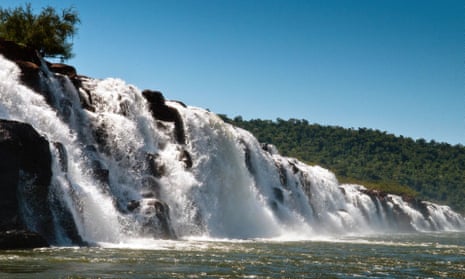
These falls on the Uruguay River dividing Brazil and Argentina are often overlooked by travellers seeking the undoubted majesty of its big brother, Iguazu, 300km away. We visited Moconá Falls when staying at Don Enrique Lodge, about 50km from the falls, after a tip from our hosts. A 4WD taxi down miles of dirt tracks followed by an hour’s rib-boat trip took us to the 3km-long falls. Uniquely, the falls run the length of the river and although only about 20 metres high, they are breathtaking. Moconá translates in the Guarani language as “to swallow everything”, an entirely justified description. Not easy to reach but an unforgettable experience. Also known as the Yucumã Falls, this incredible sight can also be viewed from the Brazilian side.
Paul Hammond
Snoqualmie, Washington State, US

This is the 82-metre waterfall (about 30 metres taller than Niagara Falls) made famous internationally in the 1990s TV series Twin Peaks. One of the great things, beyond the sheer force of its visual splendour, is that Snoqualmie is accessible by public bus services from downtown Seattle (30 miles) for a few dollars, so you don’t need a hire car to get there. It’s less than a mile woodland hike to the base of the falls from the top (and there are other hikes there too).
David Chalton
Sunwapta Falls, Jasper national park, Canada

This is a perfect stopover when driving on the Icefields Parkway. The 18-metre Upper Falls are easily accessed from the car park. The cascading water, partly fed by the Athabasca Glacier, is immensely powerful in spring and early summer when meltwater volumes are at peak. Walk to the centre of the high wooden footbridge that spans the gorge to appreciate the picture-perfect sight of the towering mountains in the background, and the picturesque island of trees just before the falls. Rushing water curves dramatically around both sides of the island. Sunwapta means “turbulent river” in the Stoney First Nation people’s language. A mile’s hike leads you through forest to the Lower Falls. Watch out for bears.
Victoria
Kalandula Falls, Angola
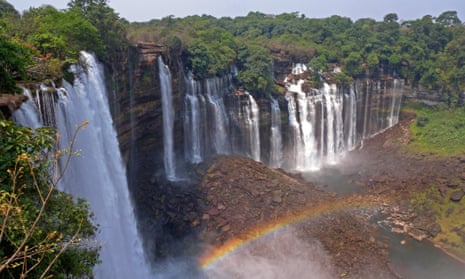
Angola is home to one of Africa’s biggest waterfalls, the Kalendula Falls, boasting an impressive width of 410 metres and a drop of 105 metres. The thundering noise, mist and setting are overwhelming. The best way to experience the falls is by hire car from Luanda, a six-hour drive on fairly rudimentary roads through varied landscapes. Alternatively, travel by train to the regional capital, Malanje, and then drive north for an hour via Lombe and Calandula. Stay at the charming Pousada Calandula (doubles from about £150). The six rooms have incredible views (and the noise) of the waterfall. The falls are best enjoyed from the B&B’s veranda with its bar.
Line Nyhagen
Ngare Ndare, Kenya
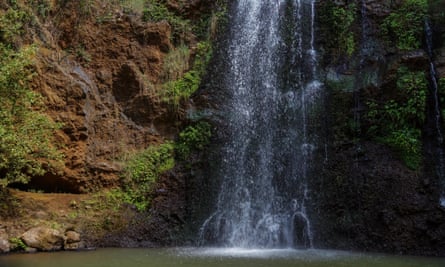
Hidden in the middle of a small, community-managed forest reserve in central Kenya, Ngare Ndare is an impossibly pretty set of waterfalls perfect for swimming in. Four amazingly clear pools stretch a kilometre from a cerulean-blue pool fed by melting ice from the slopes of nearby Mount Kenya, past a couple of smaller, steeper pools with myriad jumping opportunities for adrenalin junkies, ending with the largest fall and best swimming spot. It’s a cool 4km hike through shady forest from the main gate. Take a guide – we came across elephants.
Clare
Tappiya Falls, Philippines

In a valley of the Cordillera mountains, the journey to the Tappiyal Falls involves making your way to the small village of Batad, among the Ifuago rice terraces, a Unesco world heritage site (390km north of Manila). Hiring a local guide costs between £8 and £16 to take you on a trek along the luscious green terraces carving along mountains before a 30-minute descent to the falls. Here, the water plummets 30 metres to a huge, refreshing pool to swim in and wash off the sweat from the hike. Tappiya’s beauty isn’t solely in the falls (stunning as they are), but the journey to get there: to the remote village, the phenomenal terraces, and the tricky descent.
Laurence Britton
Nachi, Japan
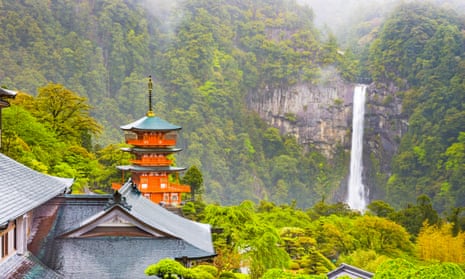
The Kumano Kodo pilgrim trail is actually a collection of routes 100km or so south of Osaka. They are among the best and most well-organised of Japanese hikes with wonderful traditional Japanese accommodation and food on route. The gem at the end of the Nakahechi route is the Nachi Falls which, with a drop of 133 metres, is Japan’s most spectacular cascade. Full details from the Kumano Travel Centre.
John Thackray
Khe Kem, Vietnam
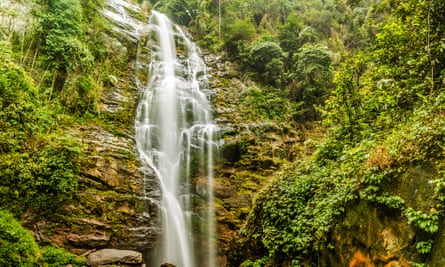
Take a rented moped (about £7) from Con Cuông in the North Central Coast region on a meandering 20km ride through chiseled mountains, alongside rural villages to access the graceful Khe Kem waterfall. |For a £1 entry fee, visitors get access to paths with bamboo rails that guide through the undergrowth towards the foot of the cascade, where a serene pool is surrounded by natural sun-baked stone loungers. Swim directly under the flowing torrent while having your feet gently nibbled by some of Pu Mat park’s fish population. If you’re lucky, as we were, an invitation to join a picnicking local family and share in food, beers and cheers might cap this magnificent experience.
Belly
Weeping Wall, Hawaii
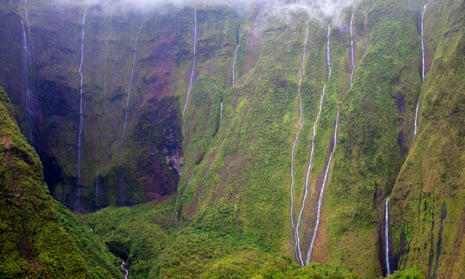
If you take one helicopter trip in your lifetime, let it be around Hawaiian island Kauai. Not only will you feel transported to the opening scene of Jurassic Park, but in one sweep you will see some of the most astonishing and remote landscapes on Earth from an unforgettable vantage. The Waimea Canyon, the towering cliffs of the Nā Pali coastline, the horseshoe reef of Tunnels beach, and the Weeping Wall. Scores of rivulets thousands of feet high fall like tears directly from the misty sky. Set against the emerald background of shield volcano Mount Waialeale: a towering physical beauty from an earlier geological age, this is one of the most astounding sights on the planet. Hiking to the falls is only feasible for experienced adventurers.
Sarah croudace
Whangarei Falls, North Island, New Zealand
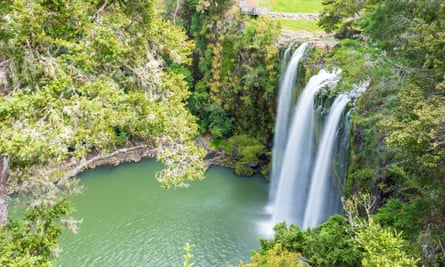
There are bigger, splashier more dramatic Kiwi waterfalls but few are as photogenic as Whangarei Falls. The spectacular 27-metre drop down a basalt cliff is set in a wooded valley. There’s a wonderful loop walk around the falls among the 500-year-old native flora and fauna. The three viewing platforms, picnic spots and well-maintained paths are balanced with the sheer beauty of the place. It’s easily accessible, a 10-minute drive out of Whangarei, with plenty of free parking and toilets. Walks to the falls from the car parks range from 15 minutes to 1.5 hours. Perfect for a picnic and exploring.
Phil Lines
Looking for a holiday with a difference? Browse Guardian Holidays to see a range of fantastic trips
